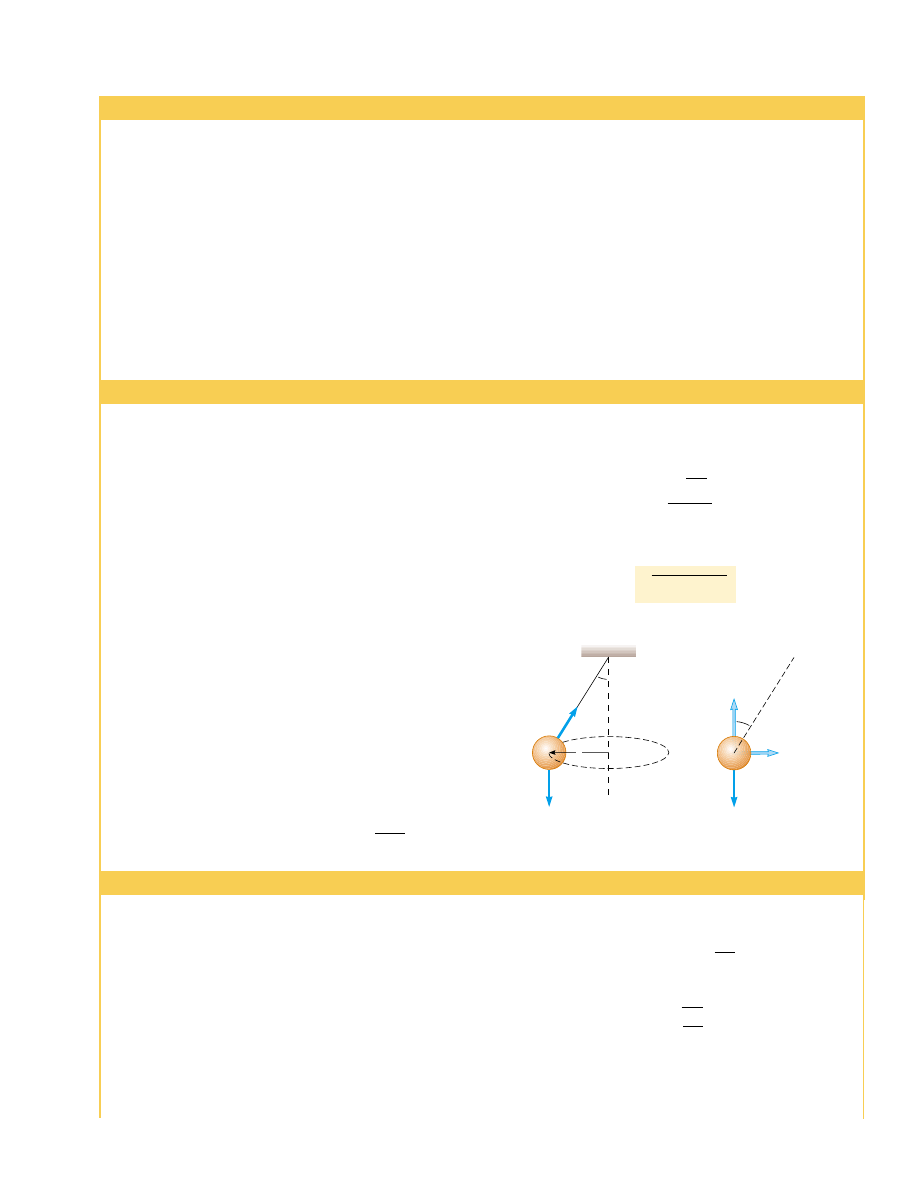Physics For Scientists And Engineers 6E - part 39

SECTION 6.1 • Newton’s Second Law Applied to Uniform Circular Motion
153
Conceptual Example 6.1 Forces That Cause Centripetal Acceleration
The force causing centripetal acceleration is sometimes
called a centripetal force. We are familiar with a variety of
forces in nature—friction, gravity, normal forces, tension,
and so forth. Should we add centripetal force to this list?
Solution No; centripetal force should not be added to this
list. This is a pitfall for many students. Giving the force caus-
ing circular motion a name—centripetal force—leads many
students to consider it as a new kind of force rather than a
new role for force. A common mistake in force diagrams is to
draw all the usual forces and then to add another vector for
the centripetal force. But it is not a separate force—it is sim-
ply one or more of our familiar forces acting in the role of a
force that causes a circular motion.
Consider some examples. For the motion of the Earth
around the Sun, the centripetal force is gravity. For an ob-
ject sitting on a rotating turntable, the centripetal force is
friction. For a rock whirled horizontally on the end of a
string, the magnitude of the centripetal force is the tension
in the string. For an amusement-park patron pressed against
the inner wall of a rapidly rotating circular room, the cen-
tripetal force is the normal force exerted by the wall. Further-
more, the centripetal force could be a combination of two
or more forces. For example, as you pass through the lowest
point of the Ferris wheel in Quick Quiz 6.1, the centripetal
force on you is the difference between the normal force ex-
erted by the seat and the gravitational force. We will not use
the term centripetal force in this book after this discussion.
Example 6.3 How Fast Can It Spin?
A ball of mass 0.500 kg is attached to the end of a cord
1.50 m long. The ball is whirled in a horizontal circle as
shown in Figure 6.1. If the cord can withstand a maximum
tension of 50.0 N, what is the maximum speed at which the
ball can be whirled before the cord breaks? Assume that the
string remains horizontal during the motion.
Solution It makes sense that the stronger the cord, the
faster the ball can twirl before the cord breaks. Also, we ex-
pect a more massive ball to break the cord at a lower speed.
(Imagine whirling a bowling ball on the cord!)
Because the force causing the centripetal acceleration in
this case is the force T exerted by the cord on the ball,
Equation 6.1 yields
Solving for v, we have
This shows that v increases with T and decreases with larger
m, as we expect to see—for a given v, a large mass requires a
large tension and a small mass needs only a small tension.
The maximum speed the ball can have corresponds to the
v !
√
Tr
m
(1)
T ! m
v
2
r
Example 6.2 The Conical Pendulum
A small object of mass m is suspended from a string of
length L. The object revolves with constant speed v in a hor-
izontal circle of radius r, as shown in Figure 6.4. (Because
the string sweeps out the surface of a cone, the system is
known as a conical pendulum.) Find an expression for v.
Solution Conceptualize the problem with the help of Fig-
ure 6.4. We categorize this as a problem that combines equi-
librium for the ball in the vertical direction with uniform
circular motion in the horizontal direction. To analyze the
problem, begin by letting " represent the angle between
the string and the vertical. In the free-body diagram shown,
the force
T exerted by the string is resolved into a vertical
component T cos " and a horizontal component T sin " act-
ing toward the center of revolution. Because the object does
not accelerate in the vertical direction, F
y
!
ma
y
!
0 and
the upward vertical component of
T must balance the down-
ward gravitational force. Therefore,
Because the force providing the centripetal acceleration in
this example is the component T sin ", we can use Equation
6.1 to obtain
(2)
!
F ! T
sin
" !
ma
c
!
mv
2
r
(1)
T
cos
" !
mg
!
Dividing (2) by (1) and using sin "/cos " ! tan ", we elimi-
nate T and find that
From the geometry in Figure 6.4, we see that r ! L sin ";
therefore,
v !
Note that the speed is independent of the mass of the object.
√
Lg
sin
"
tan
"
v !
√
r
g
tan
"
tan
" !
v
2
r
g
T
mg
T cos
mg
T sin
r
θ
θ
θ
θ
L
Figure 6.4 (Example 6.2) The conical pendulum and its free-
body diagram.